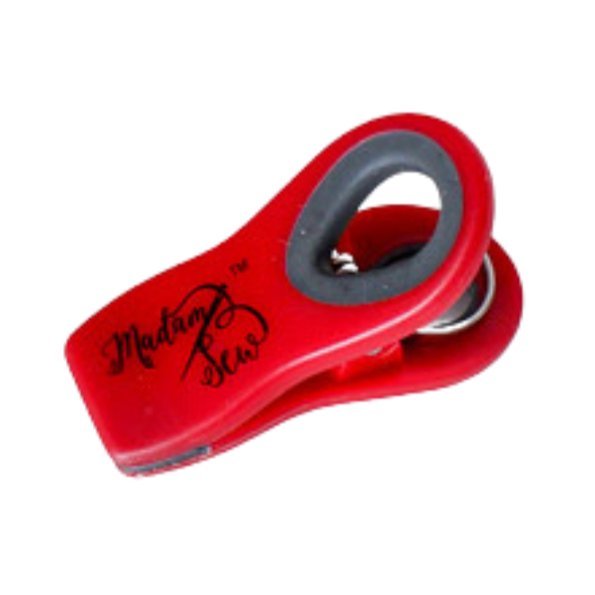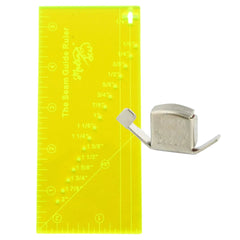Cutting and Chain-Piecing Half-Square Triangle Blocks to Make a Quilted Pillow
I have an exciting project: Let’s make a quilted pillow and learn some basic quilting techniques in the process. We are going to learn to make half-square triangles, how to choose a design, how to assemble them efficiently into a quilt top and I’ll even show you how to insert a zipper!
If you think you need more help getting started with quilting, browse through our quilting beginner series and get al the help you are looking for.
Are you in for this quilted pillow? Let’s get started!
In this first installment, we’ll learn how to cut and chain piece half-square triangle blocks. The half-square triangle is one of the simplest blocks you can make, but also one of the more versatile ones; depending on how you position them you can create many different designs.
Tools and Materials
- Non-slip ruler 6x24 inches
- Non-slip ruler 6x6 inches
- Rotary cutter
- 1/4" presser foot with guide ( also #10 in the 32 Presser Foot Set )
- Heat erasable fabric marking gel pens
- Pins
- ¼ yard background fabric
- 4 fat eighths (9x22) in different prints (you can also use smaller scraps, as long as you can cut two 5x5” squares of each print)
- Heavy spray starch
Cutting
Fold each fat eighth in half matching the short ends. Check that your fabric is squared and has nice straight edges, if not, use your rotary cutter to straighten them.
Align your ruler’s 5” mark with one of the sides (perpendicular to the fold) and cut a strip.
Turn the still folded strip sideways, align your ruler’s 5” mark with the end opposite the fold and cut a 5” square (this will give you two squares, since the fabric is folded).
Fold your background fabric in half, matching the selvedges, and cut a total of eight squares in the same manner.
Marking
You only need to mark your background fabric. Stack your eight squares wrong side up and use your ruler and gel pen to mark a diagonal line from corner to corner on each square.
Chain Piecing
Now the fun begins! Pair each marked background square with a print square, right sides together, and pin. For such a small seam one pin is enough.
Stack your pairs with the marked side up and bring to your sewing machine.
Align the marked line of your first square with the guide of your ¼” foot (your line will go under the guide and the seam will be to its left), and sew a straight line to the other end.
Without cutting the tread or lifting the presser foot, pick up the next square and repeat the previous step.
Continue working in this way until you have sewn all the squares.
Now pick up the last square of the chain you have just made, and again align the marked line with the guide of the foot so that you will be sewing a second line of stitches on the other side of it.
Repeat until you go through every square on your chain.
Cutting and Pressing
Snip the squares apart and give them a quick press to set the seams. Then use your ruler and rotary cutter to cut each square along the marked line.
Place your triangles on the ironing board with the print side up and the point towards you. Open them up to reveal your half-square triangle blocks and gently press the top triangle away from you so that the seam folds towards the darker side.
Spray them with the starch before giving them one final press. The starch will stabilize the fabric slightly and make the blocks easier to handle during the rest of the process.
Squaring Up
If you remember, our squares are 5x5 inches, but our blocks will be 4½”, we gave ourselves that extra ½” to accommodate for the variations in stitching and alignment that inevitably occur as we handle the squares. Now we are going to trim them down to the right size and get rid of those dog ears that are left after seaming and cutting. In theory, we can do this with the 6x24” ruler, but it is unwieldy, so we are going to use the square 6x6” ruler.
If you are looking for extra information about squaring up a quilt or quilt block, check out this tutorial we published on the blog.
Lay your first square on the cutting mat, with the seam pointing towards your dominant hand.
Lay the corner of your square ruler with the 1” marking over the block, taking care that the seam runs along the diagonal, hitting the corners of the squares marked on the ruler and making sure that the 4½” marking lies slightly within the block.
Trim the two edges closer to your dominant hand.
Rotate the block 180 degrees, this time aligning the 4½” marking with the freshly trimmed edges. Trim the last two sides.
And that’s all there is to it. Your quilt blocks to make a pillow are ready! In part 2 of this series, we will work on finding a design and putting our blocks together into a quilt top.
- Go to Part 2 of this Quilted Pillow Series: Designing and Assembling a Quilt Top with Half-Square Triangle Blocks
- Go to Part 3 of this Quilted Pillow Series: Quilting and Inserting a Zipper
We published different blogs about half square triangles because they are used a lot in modern quilting. Here are two that might spark your interest.
If you have any questions, don't hesitate to leave a comment!
Happy Quilting!
Ana
Blogging for Madam Sew



















